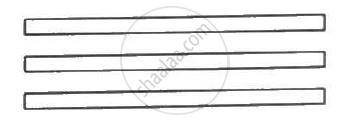Advertisements
Advertisements
प्रश्न
Draw a labelled diagram of Van de Graaff generator. State its working principle to show how by introducing a small charged sphere into a larger sphere, a large amount of charge can be transferred to the outer sphere. State the use of this machine and also point out its limitations.
उत्तर
Van de Graaff generator is a device used for building up high potential differences of the order of a few million volts.
Principle − It is based on the principle that charge given a hollow conductor is transferred to the outer surface and is distributed uniformly over it.
Construction:

It consists of a large spherical conducting shell (S) supported over the insulating pillars. A long narrow belt of insulating material is wound around two pulleys P1 and P2. B1 and B2 are two sharply pointed metal combs. B1 is called the spray comb and B2 is called the collecting comb.
Working − The spray comb is given a positive potential by a high tension source. The positive charge gets sprayed on the belt.
As the belt moves and reaches the sphere, a negative charge is induced on the sharp ends of the collecting comb B2 and an equal positive charge is induced on the farther end of B2.
This positive charge shifts immediately to the outer surface of S. Due to discharging action of sharp points of B2, the positive charge on the belt is neutralised. The uncharged belt returns downwards and collects the positive charge from B1, which in turn is collected by B2. This process is repeated and the positive charge on S goes on accumulating. In this way, voltage differences of as much as 6 or 8 million volts (with respect to the ground) can be built up
Use: Van de Graaff generator generates high potential differences that are used to accelerate charged particles such as electrons, protons, ions, etc. used for nuclear disintegration.
Limitations: 1) It's a series combination that allows only one route for the movement of charge.
2) It can accelerate only the charged particles not the uncharged particles.
APPEARS IN
संबंधित प्रश्न
A metal rod of square cross-sectional area A having length l has current I flowing through it when a potential difference of V volt is applied across its ends (figure I). Now the rod is cut parallel to its length into two identical pieces and joined as shown in figure II. What potential difference must be maintained across the length of 2l. so that the current in the rod is still I?

Explain the principle of a device that can build up high voltages of the order of a few million volts.
A charge of `+2.0 xx 10^-8 C` is placed on the positive plate and a charge of `-1.0 xx 10^-8 C` on the negative plate of a parallel-plate capacitor of capacitance `1.2 xx 10^-3 "uF"` . Calculate the potential difference developed between the plates.
A charge of 20 µC is placed on the positive plate of an isolated parallel-plate capacitor of capacitance 10 µF. Calculate the potential difference developed between the plates.
The capacitance between the adjacent plates shown in the figure is 50 nF. A charge of 1.0µC is placed on the middle plate. If 1.0 µC is placed on the upper plate instead of the middle, what will be the potential difference between (a) the upper and the middle plates and (b) the middle and the lower plates?

In circuits, a difference in potential from one point to another is often called ______.
Two metal pieces having a potential difference of 800 V are 0.02 m apart horizontally. A particle of mass 1.96 × 10–15 kg is suspended in equilibrium between the plates. If e is the elementary charge, then charge on the particle is ______.
Assertion: Electric potential and electric potential energy are different quantities.
Reason: For a system of positive test charge and point charge electric potential energy = electric potential.
A and B are two points in an electric field. If the work done in carrying 4.0C of electric charge from A to B is 16.0 J, the potential difference between A and B is:
An α-particle and a proton are accelerate at same potential difference from rest. What will be the ratio of their final velocity?
